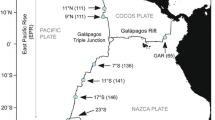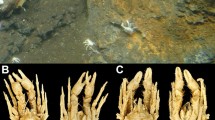Abstract
Among chemosymbiotic metazoans found at deep-sea hydrothermal vents, cold seeps and organic falls, members of the mussel clade Bathymodiolinae (Bivalvia: Mytilidae) have evolved interactions with a higher diversity of bacterial lineages than other bivalve groups. Here, we characterized the bacteria associated with “Bathymodiolus” mauritanicus and Idas-like specimens from three sites in the Northeast Atlantic (two mud volcanoes in the Gulf of Cadiz and one seamount of the Gorringe Bank). Phylogenetic analysis of bacterial 16S rRNA-encoding gene sequences demonstrated that “B”. mauritanicus has a dual symbiosis dominated by two phylotypes of methane-oxidising bacteria and a less abundant phylotype of a sulphur-oxidising bacterium. The latter was the dominant phylotype in a sympatric population of Idas-like mussels at the Darwin mud volcano. These results are the first report of a bacterial phylotype shared between two deep-sea mussels from divergent clades. This sulphur-oxidising bacterium was absent from Idas-like specimens from the other two sites (Gorringe Bank and Meknès mud volcano), in which bacterial clone libraries were dominated by other Gammaproteobacteria related to symbionts previously identified in Idas modiolaeformis from the Eastern Mediterranean. All Idas-like specimens studied herein are closely related and also related to I. modiolaeformis. However, they probably display different associations with bacteria, with the possible absence of both methane- and sulphur-oxidising symbionts at the Gorringe Bank. These results draw a very complex picture of associations between mussels and bacteria in the Northeast Atlantic, which could be highly variable depending on locale characteristics of the habitats.




Similar content being viewed by others
References
Altschul SF, Madden TL, Schaeffer AA, Zhang J, Zhang Z, Miller W, Lipman DJ (1997) Gapped BLAST and PSI-BLAST: a new generation of protein database search programs. Nucleic Acids Res 25(17):3389–3402
Amann R, Blinder BJ, Olson RJ, Crisholm SW, Devereux R, Stahl DA (1990) Combination of 16 s rRNA-target oligonucleotide probes with flow cytometry for analyzing mixed microbial populations. Appl Environ Microbiol 56:1919–1925
Barry JP, Buck KR, Kochevar RK, Nelson DC, Fujiwara Y, Goffredi SK, Hashimoto J (2002) Methane-based symbiosis in a mussel, Bathymodiolus platifrons from cold seeps in Sagami Bay, Japan. Invertebr Biol 121(1):47–54
Bell, KLC, Fuller SA eds. (2011). New Frontiers in Ocean Exploration: The E/V Nautilus 2010 Field Season. Oceanography 24(1), supplement, 40 pp, http://dx.doi.org/10.5670/oceanog.24.1.supplement
Cavanaugh CM (1983) Symbiotic chemoautotrophic bacteria in marine invertebrates from sulphide-rich habitats. Nature, Lond 302:58–61
Childress JJ, Fisher CR, Brooks JM, Kennicutt MC, Bidigare RR, Anderson AE (1986) A methanotrophic marine molluscan (Bivalvia, Mytilidae) symbiosis: mussels fueled by gas. Science 19:1306–1308
Cole JR, Chai B, Marsh TL, Farris RJ, Wang Q, Kulam SA, Chandra S, McGarrell DM, Schmiedl TM, Garrity GM, Tiedje JM (2003) The Ribosomal Database Project (RDP-II): previewing a new auto aligner that allows regular updates and the new prokaryotic taxonomy. Nucleic Acids Res 31(1):442–443
Cosel R (2002) A new species of bathymodioline mussel (Mollusca, Bivalvia, Mytilidae) from Mauritania (West Africa), with comments on the genus Bathymodiolus Kenk & Wilson, 1985. Zoosystema 24(2):259–271
DeChaine EG, Cavanaugh CM (2006) Symbioses of methanotrophs and deep-sea mussels (Mytilidae: Bathymodiolinae). In: Overmann J (ed) Progress in molecular and subcellular biology. Molecular basis of symbiosis, vol 41. Springer, Berlin, pp 227-249
Deming JW, Reysenbach AL, Macko S, Smith CR (1997) Evidence for the microbial basis of a chemoautotrophic invertebrate community at a whale fall on the deep seafloor: bone-colonizing bacteria and invertebrate endosymbionts. Microsc Res Tech 37:162–170
Dubilier N, Windoffer R, Giere O (1998) Ultrastructure and stable carbon isotope composition of the hydrothermal vent mussels Bathymodiolus brevior and B. sp. affinis brevis from the north Fiji Basin, western Pacific. Mar Ecol Prog Ser 165:187–193
Duperron S (2010) The diversity of deep-sea mussels and their bacterial symbioses. In: Kiel S (ed) The vent and seep biota. Topics in geobiology, vol 33. Springer, Netherlands, pp 137-167
Duperron S, Nadalig T, Caprais JC, Sibuet M, Fiala-Médioni A, Amann R, Dubilier N (2005) Dual symbiosis in Bathymodiolus sp. mussel from a methane seep on the Gabon continental margin (Southeast Atlantic): 16S rRNA phylogeny and distribution of the symbionts in gills. Appl Environ Microbiol 71(4):1694–1700
Duperron S, Bergin C, Zielinski F, Blazejak A, Pernthaler A, McKiness ZP, DeChaine E, Cavanaugh CM, Dubilier N (2006) A dual symbiosis shared by two mussel species, Bathymodiolus azoricus and Bathymodiolus puteoserpentis (Bivalvia: Mytilidae), from hydrothermal vents along the northern Mid-Atlantic Ridge. Environ Microbiol 8(8):1441–1447
Duperron S, Sibuet M, MacGregor BJ, Kuypers MMM, Fisher CR, Dubilier N (2007) Diversity, relative abundance and metabolic potential of bacterial endosymbionts in three Bathymodiolus mussel species from cold seeps in the Gulf of Mexico. Environ Microbiol 9(6):1423–1438
Duperron S, Halary S, Lorion J, Sibuet M, Gaill F (2008a) Unexpected co-occurrence of six bacterial symbionts in the gills of the cold seep mussel Idas sp. (Bivalvia: Mytilidae). Environ Microbiol 10(2):433–445
Duperron S, Laurent MCZ, Gaill F, Gros O (2008b) Sulphur-oxidizing extracellular bacteria in the gills of Mytilidae associated with wood falls. FEMS Microbiology Ecology 63:338–349
Duperron S, Lorion J, Samadi S, Gros O, Gaill F (2009) Symbioses between deep-sea mussels (Mytilidae: Bathymodiolinae) and chemosynthetic bacteria: diversity, function and evolution. CR Biologies 332:298–310
Felsenstein J (2002) PHYLIP (Phylogeny Inference Package). Distributed by the author. Department of Genome Sciences, University of Washington. Seatle
Gaudron SM, Pradillon F, Pailleret M, Duperron S, Le Bris N, Gaill F (2010) Colonization of organic substrates deployed in deep-sea reducing habitats by symbiotic species and associated fauna. Mar Environ Res 70(1):1–12
Genio L, Johnson SB, Vrijenhoek RC, Cunha MR, Tyler PA, Kiel S, Little CTS (2008) New record of Bathymodiolus mauritanicus Cosel 2002 from the Gulf of Cadiz (NE Atlantic) mud volcanoes. J Shellfish Res 27(1):53–61
Gros O, Guibert J, Gaill F (2007) Gill-symbiosis in mytilidae associated with wood fall environments. Zoomorphology 126:163–172
Holmes AJ, Costello A, Lidstrom ME, Murrell JC (1995) Evidence that particulate methane monooxygenase and ammonia monooxygenase may be evolutionarily related. FEMS Microbiol Let 132:203–208
Jones WJ, Won YJ, Maas PAY, Smith PJ, Lutz RA, Vrijenhoek RC (2006) Evolution of habitat use by deep-sea mussels. Mar Biol 148(4):841–851
Lane DJ (1991) 16S/23S rRNA sequencing. In: Stackebrandt E, Goodfellow M (eds) Nucleic acid techniques in bacterial systematics. Wiley, New York, pp 115–175
Lorion L, Duperron S, Gros O, Cruaud C, Samadi S (2009) Several deep-sea mussels and their associated symbionts are able to live both on wood and on whale falls. P Roy Soc Lon B 276:177–185
Lorion J, Buge B, Cruaud C, Samadi S (2010) New insights into diversity and evolution of deep-sea Mytilidae (Mollusca: Bivalvia). Mol Phylogenetic Evol 57(1):71–83
Lorion S, Halary S, do Nascimento J, Samadi S, Couloux A, Duperron S (2012) Evolutionary history of Idas sp. Med (Bivalvia, Mytilidae), a cold seep mussel bearing multiple symbionts. Cah. Biol. Mar. 53(1):77-87
Meyer B, Kuever J (2007) Molecular analysis of the distribution and phylogeny of dissimilatory adenosine-59-phosphosulfate reductase-encoding genes (aprBA) among sulphur-oxidizing prokaryotes. Microbiol 153:3478–3498
Nelson DC, Fisher CR (1995) Chemoautotrophic and methanotrophic endosymbiotic bacteria at deep-sea vents and seeps. In: Karl DM (ed) The microbiology of deep-sea hydrothermal vents. CRC Press, Boca Raton, pp 125–167
Nelson DC, Hagen KD, Edwards DB (1995) The gill symbiont of the hydrothermal vent mussel Bathymodiolus thermophilus; is a psychrophilic, chemoautotrophic, sulfur bacterium. Mar Biol 121(3):487–495
Oliver PG, Rodrigues CF, Cunha MR (2011) Chemosymbiotic bivalves from the mud volcanoes of the Gulf of Cadiz, NE Atlantic, with descriptions of new species of Solemyidae, Lucinidae and Vesicomyidae. Zookeys 113:1–38
Olu-Le Roy K, Caprais J-C, Fifis A, Fabri M-C, Galeron J, Budzinsky H, Le Menach K, Khripounoff A, Ondreas H, Sibuet M (2007) Cold-seep assemblages on a giant pockmark off West Africa: spatial patterns and environmental control. Mar Ecol 28(1):115–130
Petersen JM, Zielinski FU, Pape T, Seifert R, Moraru C, Amann R, Hourdez S, Girguis PR, Wankel SD, Barbe V, Pelletier E, Fink D, Borowski C, Bach W, Dubilier N (2011) Hydrogen is an energy source for hydrothermal vent symbioses. Nature 476:176–180
Pimenov NV, Kalyuzhnaya MG, Khmelenina VN, Mityushina LL, Trotsenko YA (2002) Utilization of methane and carbon dioxide by symbiotrophic bacteria in gills of mytilidae (Bathymodiolus) from the Rainbow and Logatchev Hydrothermal fields on the Mid-Atlantic Ridge. Microbiol 71(5):587–594
Rodrigues CF, Duperron S (2011) Distinct symbiont lineages in three thyasirid species (Bivalvia: Thyasiridae) from the eastern Atlantic and Mediterranean Sea. Naturwissenschaften 98(4):281–287
Rodrigues CF, Oliver PG, Cunha MR (2008) Thyasiroidea (Mollusca: Bivalvia) from the mud volcanoes of the Gulf of Cadiz (NE Atlantic). Zootaxa 1752:41–56
Rodrigues CF, Webster G, Cunha MR, Duperron S, Weightman AJ (2010) Chemosynthetic bacteria found in bivalve species from mud volcanoes of the Gulf of Cadiz. FEMS Microbiol Ecol 73(3):486–499
Ronquist F, Huelsenbeck JP (2003) MrBayes 3: Bayesian phylogenetic inference under mixed models. Bioinformatics 19(2):1572–1574
Southward EC (2008) The morphology of bacterial symbioses in the gills of mussels of the genera Adipicola and Idas (Bivalvia: Mytilidae). J Shellfish Res. 1-11
Stewart FJ, Young CR, Cavanaugh CM (2009) Evidence for homologous recombination in intracellular chemosynthetic clam. Mol Biol Evol 26(6):1391–1404
Thompson JD, Gibson TJ, Plewniak F, Jeanmougin F, Higgins DG (1997) The Clustal X-Windows interface: flexible strategies for multiple sequence alignments aided by quality analysis tools. Nucleic Acids Res 25(24):4876–4882
Won Y, Hallam SJ, Mullan GD, Pan I, Buck KR, Vrijenhoek RC (2003) Environmental acquisition of thiotrophic endosymbionts by deep-sea mussels of the genus Bathymodiolus. Applied Environ Microbiol 69(11):6785–6792
Won YJ, Jones WJ, Vrijenhoek RC (2008) Absence of cospeciation between deep-sea mytilids and their thiotrophic endosymbionts. Journal of Shellfish Research 27(1):129-138
Acknowledgments
Thanks are due to Jean-Pierre Henriet (chief scientist of the cruise B09/14b) and the pilots of the ROV Genesis (research vessel Belgica) for the collection of the CHEMECOLI experiments. This research also used samples provided by the E/V Nautilus Exploration Program, Expedition NA017. We thank the four reviewers for their very helpful comments. This research was supported by the European Commission Seventh Framework Programme (FP7/2007–2013) under the HERMIONE project contract 226354, french ANR DeepOases, GDRE—DIWOOD and CHEMECO ESF EURODEEP (Fundação para a Ciência e a Tecnologia (FCT); EURODEEP/0001/2007). CFR was also supported by a postdoctoral fellowship (SFRH/BPD/64154/2009) from FCT (Portugal).
Author information
Authors and Affiliations
Corresponding author
Additional information
Communicated by: Sven Thatje
Electronic supplementary material
Below is the link to the electronic supplementary material.
Fig. 1S
(DOCX 65 kb)
Rights and permissions
About this article
Cite this article
Rodrigues, C.F., Cunha, M.R., Génio, L. et al. A complex picture of associations between two host mussels and symbiotic bacteria in the Northeast Atlantic. Naturwissenschaften 100, 21–31 (2013). https://doi.org/10.1007/s00114-012-0985-2
Received:
Revised:
Accepted:
Published:
Issue Date:
DOI: https://doi.org/10.1007/s00114-012-0985-2




